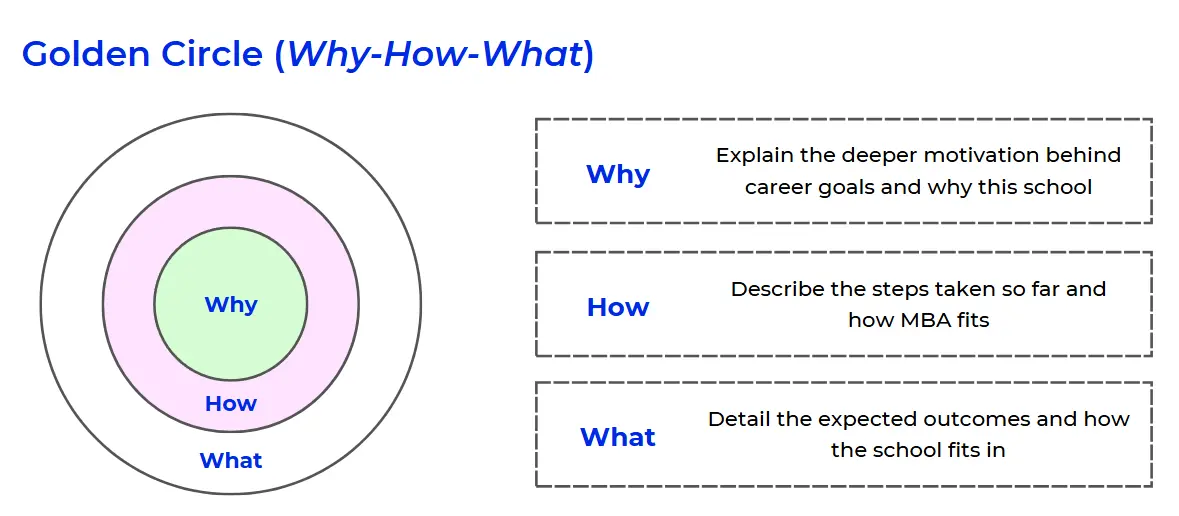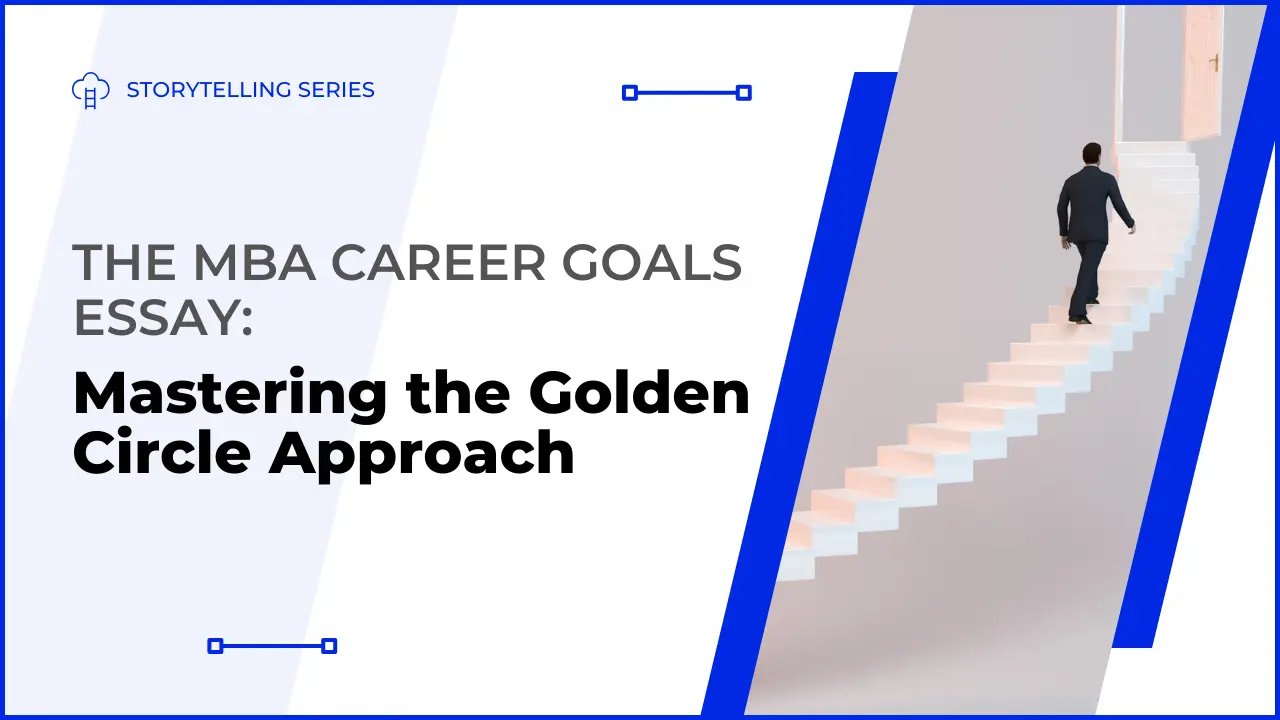Introduction: Why Your Career Goals Essay Can Make or Break Your MBA Application
Picture this:
You’re an admissions officer at Stanford GSB. You’ve just read your 100th “I want to be a consultant/banker/tech entrepreneur” essay of the day. Your eyes are glazing over. You reach for another coffee.
Then, you start reading an essay that makes you forget about your caffeine craving. An essay that doesn’t just tell you what the applicant wants to do, but why it matters. An essay that doesn’t just list achievements, but paints a vivid picture of a future you can’t wait to see unfold.
That, my friend, is the power of a killer MBA career goals essay.
Here’s a mind-blowing stat:
According to GMAC, 87% of employers say that focusing on career goals is the number one thing applicants can do to stand out.
But here’s the kicker: Most applicants focus on the what and how, completely missing the why.
That’s a mistake they’ll surely regret…
In this ultimate guide, you’ll discover:
- The “Golden Circle” approach that will transform your career goals essay from snooze-fest to page-turner
- How to craft a compelling “Why” that will make admissions officers champion your application
- The secret to aligning your goals with your past experiences and your target MBA program
- Real examples of career goals essays that got applicants into top B-schools (and why they worked)
- Plus, we’ll tackle the top 10 FAQs about MBA career goals essays to ensure you’re fully equipped to nail this crucial part of your application.
Ready to turn your career goals essay from meh to magnificent? Let’s dive in!
Start Your MBA Journey with a Free Profile Evaluation Today
Start Your MBA Journey with a Free Profile Evaluation Today
Part 1: Understanding the Golden Circle Approach
Before we jump into the nitty-gritty of essay writing, let’s talk about a game-changing concept: Simon Sinek’s Golden Circle.
What is the Golden Circle?

The Golden Circle is a simple but powerful model that consists of three concentric circles:
- Why (innermost circle)
- How (middle circle)
- What (outermost circle)
Most people communicate from the outside in. They start with what they do, sometimes touch on how they do it, and rarely get to why they do it.
But here’s the secret sauce:
Inspiring leaders and organizations think, act, and communicate from the inside out. They start with the why.
How Does This Apply to Your MBA Career Goals Essay?
Imagine your essay as a three-course meal:
- The “Why” is your appetizer. It whets the admissions committee’s appetite and sets the tone for what’s to come.
- The “How” is your main course. It’s substantial and satisfying, showing how you’ll achieve your goals.
- The “What” is your dessert. It’s the tangible, sweet outcome of your journey.
Crackverbal Hack: Start brainstorming your essay by asking yourself these questions:
- Why do you want to pursue this career path? What impact do you want to make?
- How will you achieve these goals? What skills and experiences will you need?
- What specific roles or positions are you aiming for in the short and long term?
Pro Tip: Your “Why” should be so compelling that someone could disagree with your “What” but still support your “Why.”
Part 2: Crafting Your “Why” – The Heart of Your Essay
Your “Why” is your north star. It’s the driving force behind your career goals. Here’s how to nail it:
1. Dig Deep
Don’t settle for surface-level motivations. Keep asking yourself “Why?” until you hit an emotional core.
Example:
- I want to be a fintech entrepreneur. Why?
- To create innovative financial products. Ok, but Why?
- To make financial services more accessible. Ok, but Why?
- Because I believe financial inclusion is key to reducing global poverty. Jackpot!
Now that’s a “Why” that packs a punch!
2. Make It Personal
Your “Why” should be uniquely yours. Connect it to your experiences, values, and passions.
Crackverbal Insight: Use the “Pivotal Moment” technique. Identify a moment in your life that shaped your worldview or career aspirations. This adds authenticity and emotional resonance to your “Why.”
3. Think Big, But Be Authentic
Your “Why” should be ambitious but genuine. Don’t say you want to solve world hunger if your experiences don’t back it up.
Pro Tip: Use the “Grandma Test.” Explain your “Why” to your grandmother. If she gets it and believes it, you’re on the right track.
4. Align with the School’s Mission
Research your target schools’ missions and values. Find genuine connections between your “Why” and what the school stands for.
For example, if you’re applying to Berkeley Haas, known for its emphasis on innovation and social impact, your “Why” could focus on using business innovation to drive positive societal change.
Start Your MBA Journey with a Free Profile Evaluation Today
Start Your MBA Journey with a Free Profile Evaluation Today
Part 3: Developing Your “How” – The Bridge to Your Goals
Your “How” shows the admissions committee that you’re not just a dreamer, but a strategic thinker with a solid plan.
1. Showcase Your Research
Demonstrate that you understand the industry or field you’re targeting.
Example: “To achieve my goal of revolutionizing rural healthcare through telemedicine, I plan to leverage emerging technologies like 5G and AI. According to a recent McKinsey report, these technologies could potentially improve healthcare access for over 1 billion people globally.”
2. Highlight Relevant Skills and Experiences
Show how your past experiences have prepared you for your future goals.
Crackverbal Hack: Use the “Skill Bridge” technique. For each key skill needed for your goals, provide an example of how you’ve developed or demonstrated that skill in your past experiences.
3. Explain Why an MBA is Crucial
Be specific about how an MBA, particularly from your target school, fits into your plan.
Pro Tip: Mention specific courses, clubs, or initiatives at the school that align with your “How.”
4. Address Potential Obstacles
Show that you’ve thought about challenges you might face and how you plan to overcome them.
Example: “Transitioning from engineering to venture capital will be challenging. To bridge this gap, I plan to leverage the VC club at [School Name] and seek internships in VC firms during my MBA.”
Part 4: Articulating Your “What” – The Tangible Outcomes
Your “What” is the most straightforward part of your essay, but don’t underestimate its importance.
1. Be Specific, But Flexible
Provide clear short-term and long-term goals, but show that you’re open to learning and adapting.
Example: “Post-MBA, I aim to join a leading strategy consulting firm like Bain or BCG, focusing on their sustainability practice. Long-term, I envision launching my own consultancy specializing in helping traditional industries transition to sustainable practices.”
2. Show Progression
Your short-term and long-term goals should show a clear progression and growth trajectory.
Crackverbal Insight: Use the “Career Ladder” technique. Outline 2-3 steps between your short-term and long-term goals to show thoughtful career progression.
3. Quantify Your Impact
Where possible, use numbers to make your goals more tangible and impressive.
Example: “Within five years of graduation, I aim to have helped at least 100 small businesses in emerging markets secure ethical financing, supporting the creation of an estimated 1,000 jobs.”
4. Tie It Back to Your “Why”
Show how achieving these specific goals will enable you to fulfill the purpose you outlined in your “Why.”
Pro Tip: End your essay by bringing it full circle, connecting your “What” back to your “Why” for a powerful conclusion.
Start Your MBA Journey with a Free Profile Evaluation Today
Start Your MBA Journey with a Free Profile Evaluation Today
Part 5: Putting It All Together – The Golden Circle in Action
Now that we’ve broken down each component, let’s see how they all fit together in a compelling career goals essay.
Example Outline:
- Opening Hook (Why): Vivid anecdote about witnessing the impact of financial exclusion
- Expanded Why: Personal connection to the mission of financial inclusion
- How:
- Relevant past experiences in fintech and microfinance
- Specific skills to be gained from MBA program
- Post-MBA strategy for entering impact investing
- What:
- Short-term goal: Join an impact investing firm
- Mid-term goal: Lead investments in fintech for financial inclusion
- Long-term goal: Launch a fund focused on financial inclusion in emerging markets
- Conclusion: Tie back to opening anecdote, reaffirm commitment to Why
Real Essay Excerpt (Anonymized):
“The day I saw my neighbor, a brilliant local artisan, turned away from a bank loan that could have expanded her business, I understood the real cost of financial exclusion. At that moment, I committed myself to a mission: leveraging technology to make financial services accessible to everyone, regardless of their economic status.
My journey in fintech has equipped me with a deep understanding of how technology can revolutionize financial services. At TechPay, I led the development of a mobile payment system that now serves over 2 million users in rural India. This experience showed me the transformative power of financial technology, but also revealed the immense challenges in scaling such solutions.
An MBA from [School Name], with its renowned Fintech Innovation Lab and Social Impact Initiative, will be crucial in bridging the gap between my technical expertise and the business acumen needed to drive large-scale financial inclusion. I’m particularly excited about Professor [Name]’s course on ‘Blockchain for Social Impact’, which aligns perfectly with my goal of exploring decentralized finance solutions for underserved communities.
Post-MBA, I aim to join an impact investing firm like Acumen or Omidyar Network, focusing on fintech investments in emerging markets. This role will allow me to leverage my tech background and newly acquired business skills to identify and scale promising financial inclusion solutions. Within five years, I envision leading the firm’s fintech investment strategy, with the goal of improving financial access for at least 10 million unbanked individuals.
Long-term, my ambition is to launch a dedicated impact fund focusing on fintech solutions for financial inclusion in Southeast Asia and Africa. By partnering with local entrepreneurs and leveraging my network from [School Name], I aim to catalyze the growth of at least 100 fintech startups, potentially reaching 100 million unbanked individuals by 2035.
As I think back to my neighbor’s dejected face outside that bank, I’m reminded of why this mission matters. With an MBA from [School Name], I’m confident I can turn my vision of universal financial access into reality, one startup, one village, one life at a time.”
This essay effectively uses the Golden Circle approach:
- Why: Personal connection to financial exclusion, mission of universal financial access
- How: Leveraging past fintech experience, gaining new skills through MBA, strategic career progression
- What: Specific short-term (impact investing) and long-term (launching a fund) goals with quantifiable impact
Conclusion: Your Career Goals, Your MBA Ticket
You’ve done it!
You’ve mastered the art of crafting a compelling career goals essay using the Golden Circle approach.
Let’s recap your journey:
- You’ve learned to start with a powerful “Why” that drives your ambitions
- You’ve discovered how to articulate a clear “How” that shows you’re strategic and prepared
- You’ve mastered presenting a concrete “What” that makes your goals tangible and exciting
- You’ve got answers to all your burning questions about career goals essays
But remember: This essay is just one piece of your MBA application puzzle.
Key takeaways:
- Your career goals essay should align with the rest of your application
- Be authentic – let your true passions and motivations shine through
- Show that you’ve done your homework on both your target industry and the MBA program
So, what’s next?
It’s time to put these strategies into action. Start with your “Why,” research your “How,” and define your “What.” Then, weave them together into an essay that will make admissions committees champion your candidacy.
But if you find yourself staring at a blank page, or if you want that extra edge to make your essay truly stand out, remember: You don’t have to do this alone.
At Crackverbal, we’ve helped thousands of applicants craft career goals essays that have opened doors to top B-schools. Our MBA Application service provides personalized feedback to ensure your essay hits all the right notes.
Ready to turn your MBA dreams into reality?
Your future at a top B-school is closer than you think. Let’s make your career goals roar!





0 Comments